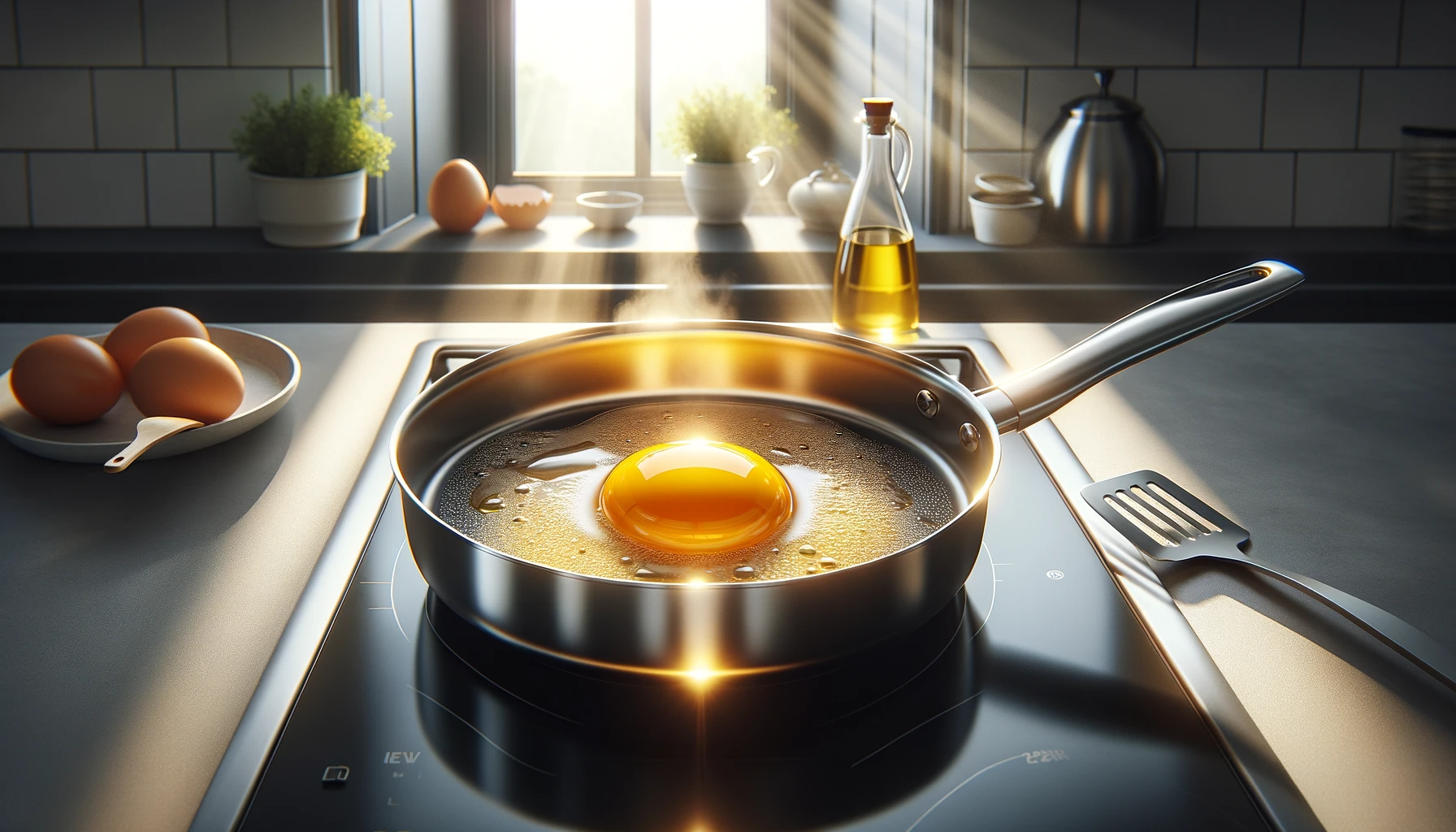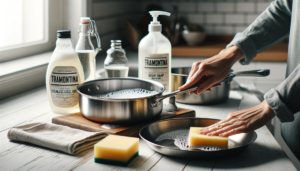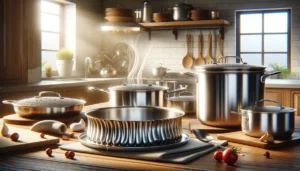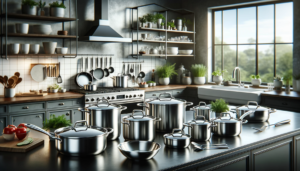Do your eggs stick and burn when cooking in stainless steel pans? Learn how to fry eggs flawlessly using the right cookware and techniques.
Cooking eggs in stainless steel may seem tricky compared to nonstick pans, but with a few tips on choosing the right pan, seasoning the surface, and frying at optimal heat, you can enjoy perfect eggs for breakfast and beyond.
Let’s dive into choosing an optimal stainless steel skillet and mastering egg cookery on this versatile metal cookware
How to Cook Eggs on Stainless Steel Cookware?

The key to cooking eggs properly on stainless steel cookware is to choose a pan with an aluminum or copper core base that promotes even heating.
Before first use, season the pan by lightly oiling and heating the surface multiple times to fill imperfections for a smooth, nonstick finish.
When cooking eggs, use a small amount of fat or oil and moderate stovetop heat around medium.
Let eggs cook undisturbed initially so they set up before gently flipping or stirring to finish cooking.
Avoid aggressive movement which can damage eggs.
Below we’ll explore how to select the optimal stainless steel pan, prepare the surface, and fry different styles of eggs perfectly.
Why Stainless Steel is Good for Cooking Eggs

Stainless steel is an excellent material for cooking eggs for several reasons.
The smooth, nonporous surface prevents eggs from sticking to the pan while cooking which eliminates food waste and makes cleanup easier after making your morning breakfast.
Stainless steel cookware also heats evenly across the cooking surface and sides of the pan so the eggs will cook consistently without developing cold or hot spots which lead to under or overcooked eggs.
Due to these desirable cooking properties, stainless steel is almost as nonstick as traditional nonstick cookware but without the use of harmful chemical coatings.
Additionally, stainless steel has superior durability over nonstick pans so it will maintain its cooking performance for many years without degradation.
The surface will not chip or flake like nonstick coatings which can reduce the lifespan of those pans.
Stainless steel is also extremely easy to clean after cooking eggs, even if some sticking or residue occurs.
A little hot water and gentle scrubbing with a sponge or cloth is all that is needed.
Choosing the Right Stainless Steel Pan

Selecting the proper stainless steel pan is key for easier egg cooking and frying.
An optimal stainless steel frying pan for eggs will have an aluminum or copper core sandwiched between stainless steel on the interior and exterior of the pan.
The aluminum or copper base improves heat conduction so there are no cold spots when cooking.
This metal core design paired with stainless steel maximizes heat delivery for consistent cooking across the pan cooking surface leading perfectly cooked fried, scrambled, poached or omelet-style eggs.
When choosing a stainless steel skillet for eggs, opt for one with a heavier-gauge steel construction which retains heat better than thinner pans.
The heavier material also resists warping which can lead to uneven cooking.
For easier food handling when cooking eggs, look for skillets with gently sloped or curved sides so you can easily slide eggs back onto the cooking surface or flip them over using a spatula.
Avoid straight-sided skillets which hamper movement of the eggs.
Additionally, select a skillet with a comfortable handle that remains cool while the pan is heating.
Seasoning a New Stainless Steel Pan
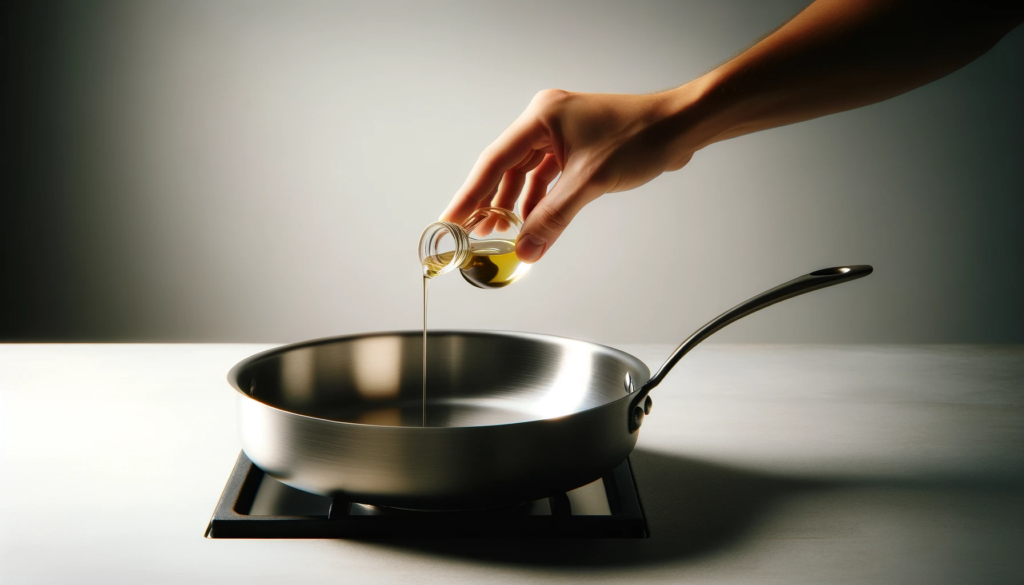
Before cooking eggs for the first time in a new stainless steel pan, proper seasoning of the cookware will create an optimal nonstick cooking surface for eggs and other foods.
Start by thoroughly washing the new pan in hot soapy water to remove any residue or debris left over from the manufacturing process.
Rinse and dry the skillet well with a soft towel.
Then, apply a very light coating of cooking oil, shortening, or butter over the entire cooking surface using a paper towel or soft cloth.
A thin layer is all that’s needed—too much oil or fat leads to excess smoke and messy cleanup later.
Swirl the oil to evenly cover then place the pan on your stovetop burner over medium-high heat.
As the pan heats, the metal will draw in the layer of fat, conditioning the cooking surface.
Allow the pan to cool before repeating the oiling and heating process two or three times.
Follow proper seasoning guidelines for your specific stainless steel skillet for best results.
Proper seasoning fills in small imperfections in the steel to make a smooth, nonstick surface.
Cooking Eggs in Stainless Steel

When ready to cook eggs, preheat your seasoned stainless steel skillet over medium-low to medium heat.
Stainless steel conducts heat more aggressively than other traditional nonstick cookware so the lower heat setting helps prevent eggs from overcooking or burning before the interior egg sets firm.
Melt a small amount of butter, olive oil, avocado oil or other cooking fat in the preheated pan to create a nonstick barrier between the stainless steel and the delicate eggs.
Swirl to coat the pan evenly.
Carefully crack eggs directly onto the hot cooking surface or break eggs into a small prep bowl first before pouring into the pan—this prevents errant pieces of shell from landing in the cooking eggs.
Allow the eggs to cook undisturbed so the egg whites have a chance to coagulate and set up creating a protective seal underneath the yolks before attempting to flip or stir the eggs.
For easy over-easy or sunny-side up eggs where the yolk remains runny, slide a heatproof lid over the stainless steel pan while the raw egg whites cook on the pan surface.
The lid traps heat and steam to gently cook the upper side of the eggs.
Alternatively, use a spoon to baste hot pan drippings over the yolks.
Avoid aggressive flipping with a spatula which can risk breaking the runny yolks prematurely.
When egg whites appear mostly set but still look glossy on top without browned, crispy edges, the eggs are likely perfectly cooked with runny yolks within.
Carefully slide eggs out of the pan onto a plate using a plastic, nylon or silicone tipped spatula for ease of lifting.
These gentle utensils won’t damage the cooking surface of well-seasoned stainless steel.
For firm scrambled eggs, continuously push cooked portions of egg gently across the cooking surface allowing raw egg to reach the hot pan below using a heatproof rubber, silicone or wooden spoon or spatula.
Avoid aggressive stirring which can toughen the eggs.
Allow curds of cooked egg to form before bringing the spatula down through the middle of the pan to fold the eggs over themselves while heating.
Repeat the folding method until eggs coagulate but remain moist looking without any visible liquid egg.
Immediately remove scrambled eggs from the stainless steel pan as soon as they finish cooking to prevent overcooking.
Always serve eggs cooked in stainless steel cookware immediately after cooking for warm, tender texture.
The retained heat in the pan continues gently cooking eggs even after removing from direct heat.
Enjoy your delicious golden brown fried, fluffy scrambled or perfectly poached eggs thanks to your easy-to-use stainless steel cookware.
Conclusion
Cooking eggs in stainless steel cookware results in delicious, consistent results every time.
With proper pan selection and seasoning, eggs slide right out of the pan and cleanup is a breeze.
Follow these tips for fried, poached, scrambled, and omelet-style eggs with runny or firm yolks cooked to perfection.
